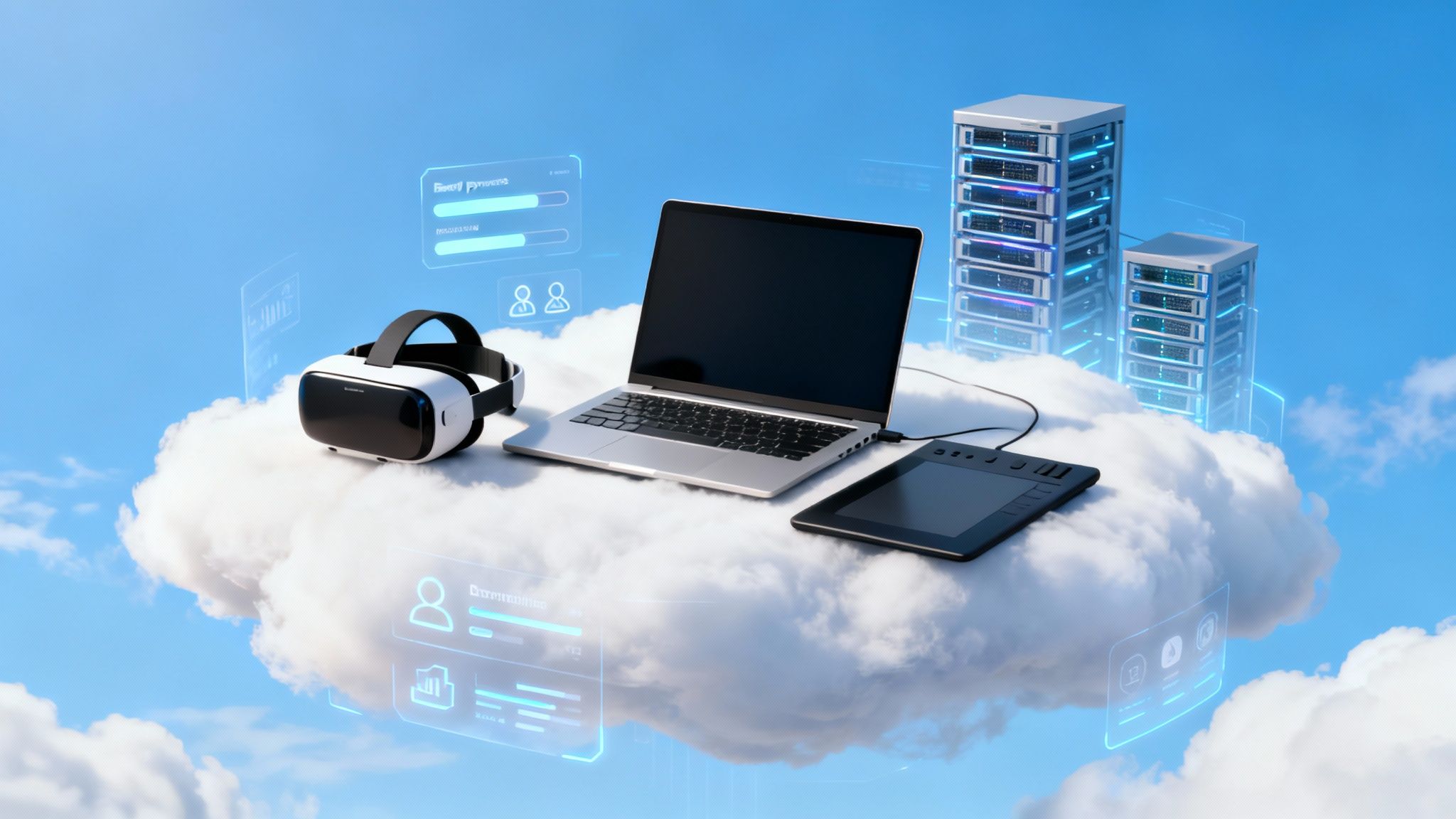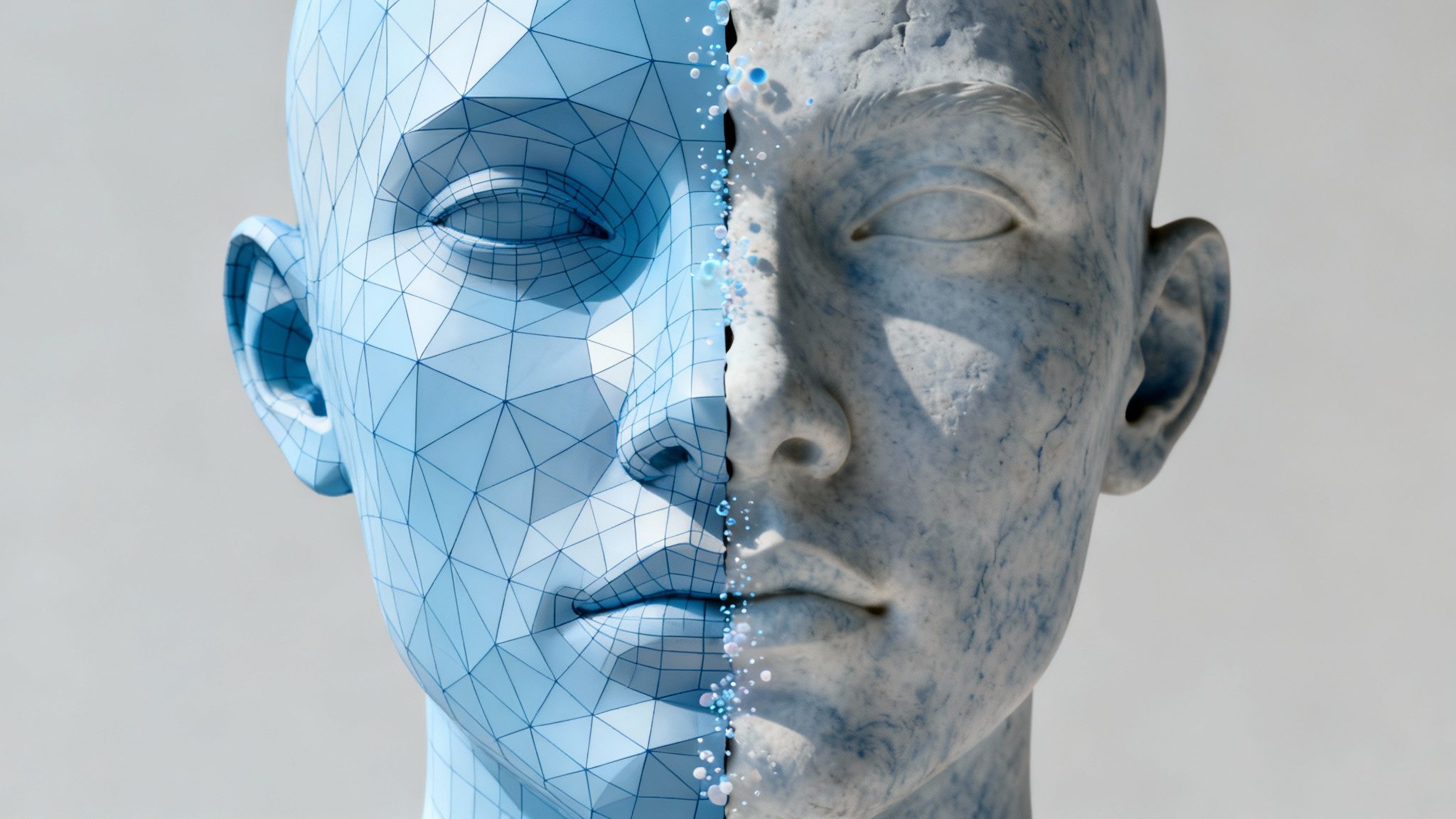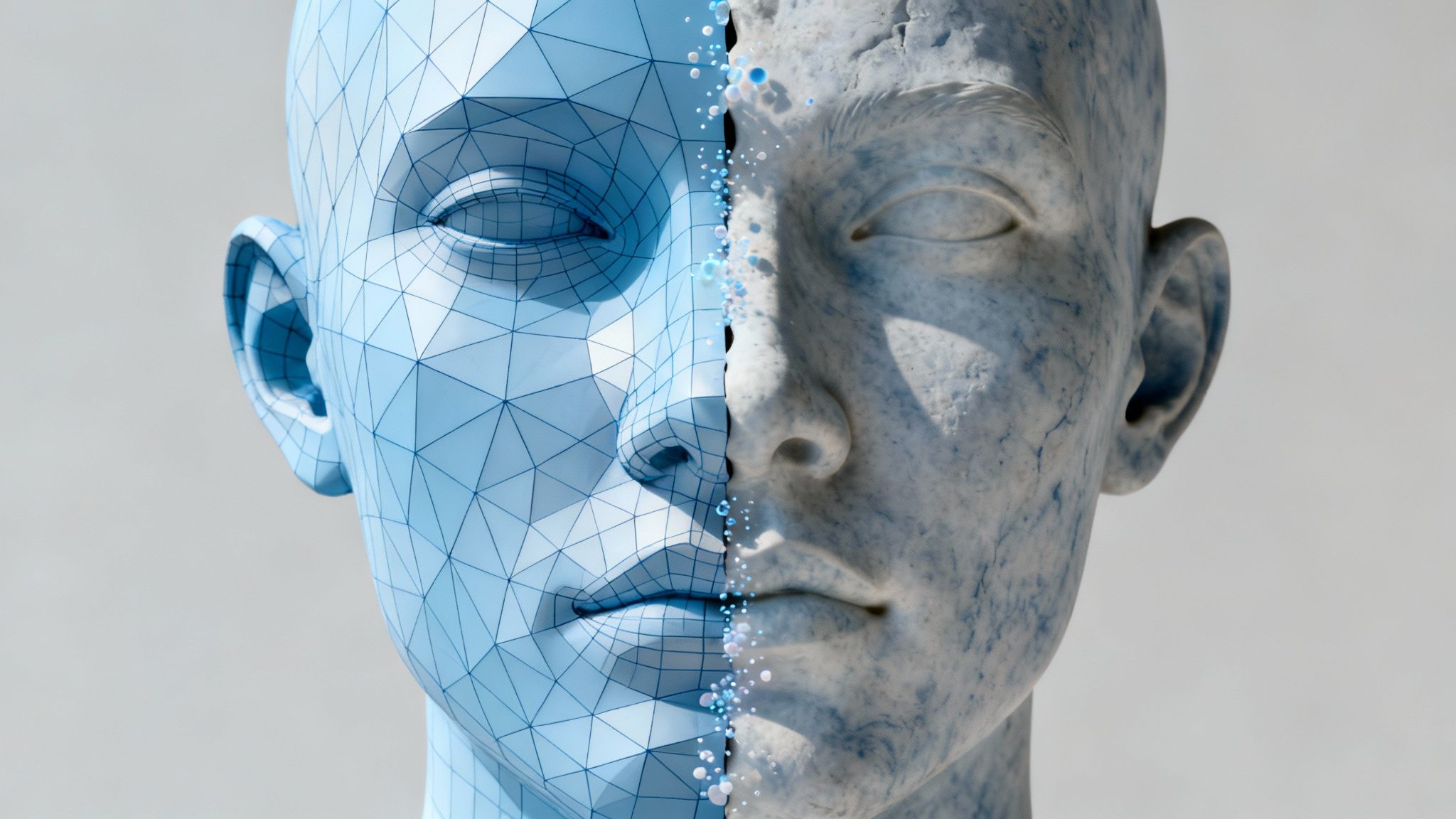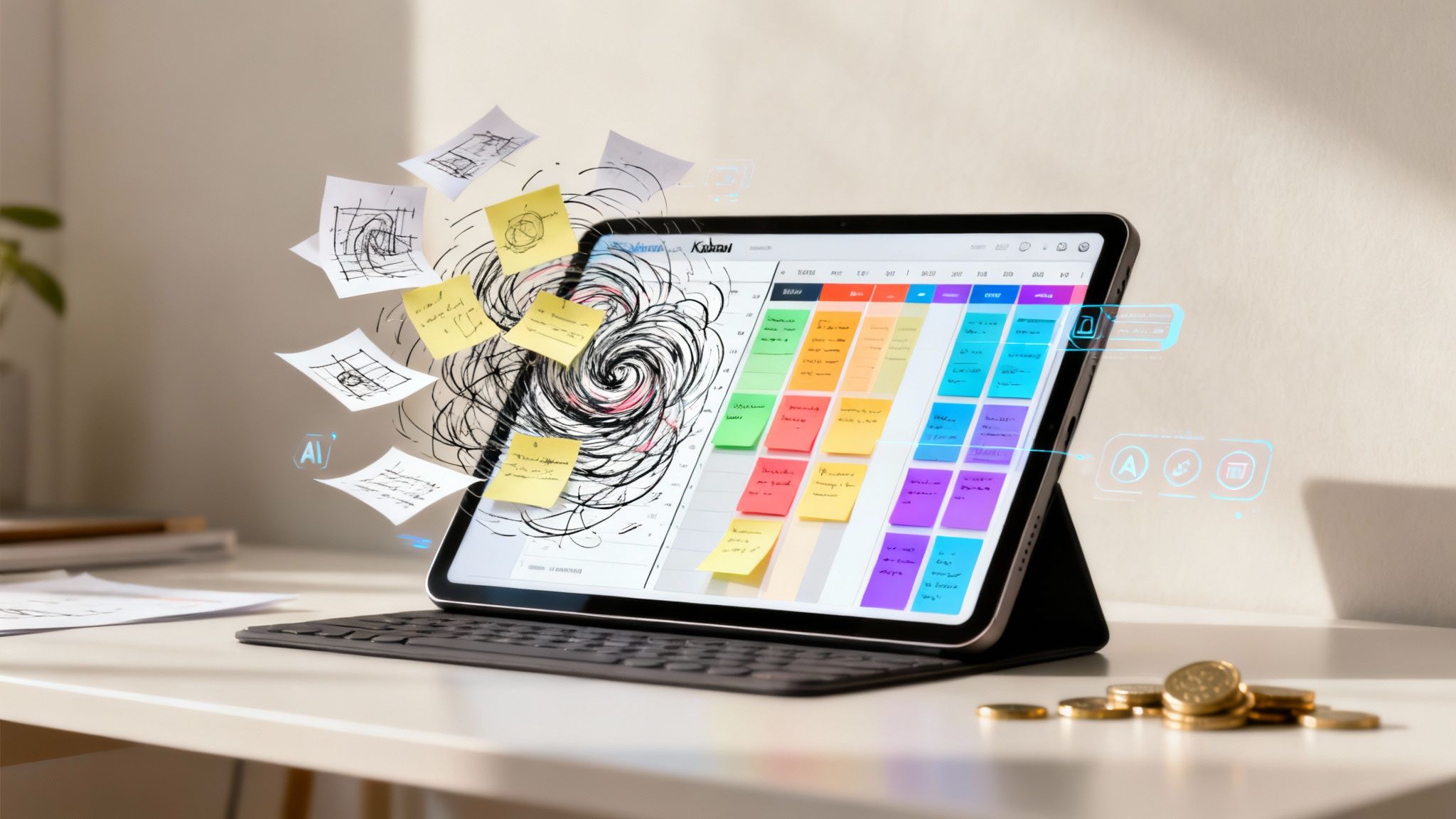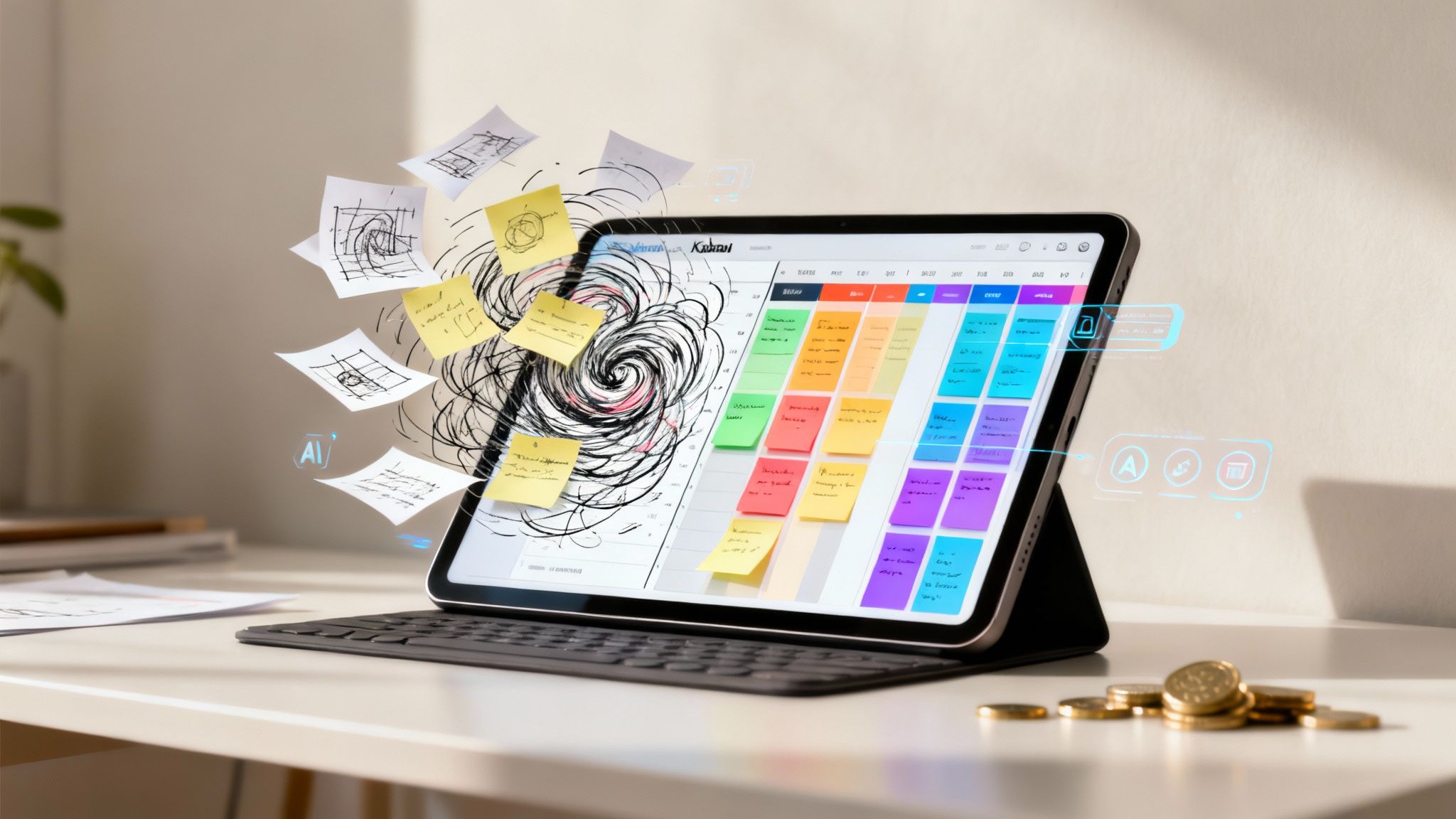Not long ago, creating a detailed 3D train model was a significant time commitment, involving hours of meticulous manual work in complex software. That entire workflow is now evolving.
AI-powered platforms are emerging not as a replacement for artists, but as a robust creative partner. For hobbyists, game developers, or VFX artists, these new tools can manage the heavy lifting of initial creation. This fundamental shift allows creative professionals to focus on what truly matters: the artistic direction and final polish of their visual projects.
The New Era of Digital Model Railroading
The days of needing weeks to build a single intricate model are becoming a thing of the past. AI-driven platforms have lowered the barriers, making sophisticated design more accessible.
Consider this: you have an idea for a custom locomotive. Instead of spending a week modeling it, you can generate a high-quality 3D concept in minutes. This isn't just about speed; it’s about liberating creative energy. The AI handles the foundational work under your direct guidance and vision.
Why High-Quality 3D Trains Are in Demand
The demand for high-quality 3D train models extends far beyond the traditional model railroading community. These digital assets are becoming essential components in several industries, reflecting a growing market.
You'll find them in various professional applications:
- Gaming and Simulation: Developers seek realistic and diverse train models to enhance the immersion of their virtual worlds, from detailed historical simulations to dynamic action games.
- Visual Effects (VFX): The film and TV industry leverages these 3D assets to build convincing digital environments and execute complex action sequences safely and efficiently.
- Digital Collections: A growing number of collectors and hobbyists are curating virtual fleets of rare and historic engines, preserving them digitally without physical space constraints.
Market data supports this trend. The global model train market, which increasingly includes 3D train models, was valued at approximately USD 1.18 billion in 2024. Projections indicate growth to USD 2.22 billion by 2033, with a steady compound annual growth rate of about 7.23%. You can explore the details in this market research on model trains.
When you use an AI-powered platform, you’re adopting a workflow designed for modern creative projects. It’s an approach that respects your ideas while providing the tools to realize them efficiently and responsibly.
Translating Your Vision into an AI Prompt
The process of creating compelling 3d train models begins with your concept. Before the AI can generate a single polygon, it needs a clear creative brief. A vague idea leads to a generic model; a precise vision produces a high-quality result.
This is about gathering the right reference materials. Whether you aim to recreate a historic Baldwin Mikado steam engine or design a futuristic maglev, reference images and descriptive text are crucial. A good starting point is to collect high-quality photos, historical blueprints, or concept art that captures the essence of the train you envision.
Crafting the Perfect Text Prompt
Once you have your visual library, it's time to translate it into language the AI can process. Specificity is key. Simply requesting a "steam train" is likely to yield a bland outcome. You must articulate the details with your words. For those new to this, understanding AI image generation fundamentals is a great help. This practical guide on how to generate images with AI is an excellent resource.
Think like a detail-oriented artist. What defines your train?
- For a weathered, older locomotive: Try phrases like, "Heavy pitting rust on a boiler plate," "chipped paint on the cabin," or "soot stains around the smokestack."
- For a luxury passenger car: Be specific. "Polished brass fittings on handrails," "gleaming mahogany wood paneling," and "plush velvet seating visible through windows."
- For a futuristic maglev: Use details like, "Aerodynamic carbon fiber shell," "glowing blue energy conduits," or "seamless unibody construction."
This level of detail doesn't just assist the AI; it provides clear direction. The result is an initial draft that is much closer to your intended vision. We explore how this process works in our guide on text-to-3D model generation.
A well-crafted prompt acts as a blueprint for the AI. The more detail you provide—materials, textures, specific components, and overall mood—the less guesswork it has to do. This leads to a more accurate and compelling model from the outset.
Defining Your Model's Purpose
Finally, consider the model's end-use, as this should inform its complexity. For instance, a model intended for a real-time game engine must be optimized for performance, typically meaning a lower polygon count.
However, if you're creating a model for a high-resolution cinematic shot or a digital collectible, you can incorporate more intricate geometry and highly detailed textures.
Establishing this purpose upfront sets clear technical parameters for the AI. Are you creating a simple background element or a high-detail hero asset? Answering this question early ensures the model is not only visually appealing but also technically appropriate for its intended application, saving considerable time on adjustments later.
Bringing Your First 3D Train Model to Life
With your creative brief established, it’s time to transform your ideas into a tangible 3d train model. This is where your concept begins to take shape as a real digital asset, moving beyond traditional manual modeling toward a process of creative iteration.
Let's walk through an example. Suppose you want to create a classic "American 4-4-0" steam engine from the 19th century. You've gathered historical photos and prepared a detailed prompt, including terms like "wrought iron wheels," "polished brass bell," and "riveted steel boiler."
Now, you bring all of that into the Virtuall platform.
The interface allows you to input both reference images and your text prompt. Providing the AI with both visual and textual inputs helps it comprehend your vision on a deeper level, resulting in an initial generation that is remarkably close to what you envisioned.

This screenshot illustrates the process. You receive several variations of the "American 4-4-0" almost immediately. Each one interprets the prompt slightly differently, providing a fantastic range of starting points to choose from.
Iterating and Refining Your AI-Generated Model
The first generation is rarely the final version. It's the beginning of a rapid, creative dialogue with the AI. You might observe that one model has the perfect boiler shape, while another features a more accurate wheel design.
Instead of starting over, you can refine your parameters:
- Adjust the "style" controller toward photorealism or a more stylized look.
- Increase specificity in your prompt. For example, change "riveted steel boiler" to "double-riveted lap seam boiler plate" to improve historical accuracy.
- Select the most promising model and generate new variations from it to explore different materials or lighting.
This transforms the creative process into a collaborative effort with an AI partner to discover the best version of your idea. For a deeper look at the technology enabling this, see our overview of top AI tools for 3D modeling.
The purpose of the first generation is not perfection, but potential. Obtaining multiple high-quality options allows you to compare, combine, and refine ideas in minutes—a cycle that would have taken days with traditional methods.
The Growing Impact of 3D Modeling Technology
This hands-on, AI-assisted workflow is part of a major industry shift. Advanced 3D modeling has reshaped how we design complex objects, enabling hyper-realistic assets that were once difficult to achieve.
The market reflects this growth. The 3D mapping and modeling sector is projected to reach USD 16.78 billion by 2030, growing at a 16.2% compound annual growth rate.
By utilizing these powerful generation tools, you can produce complex, high-fidelity 3d train models far more efficiently. The key is to embrace an iterative loop, using each generation as a stepping stone toward a final, polished asset that meets your exact vision.
Adding Artisanal Details to Your AI Model
An AI-generated model provides a fantastic foundation, but the final touches are what elevate a concept to a professional-grade asset.
This refinement stage, handled within the Virtuall platform, is where you exercise full control to perfect your 3d train models. It's about transforming the raw AI output into a polished, bespoke piece that meets your specific project standards.
The first step is often cleaning up the mesh geometry. While AI generation is impressive, it can sometimes produce minor geometric artifacts. Addressing these early ensures a clean and efficient foundation, preventing technical issues in a game engine or render later on.
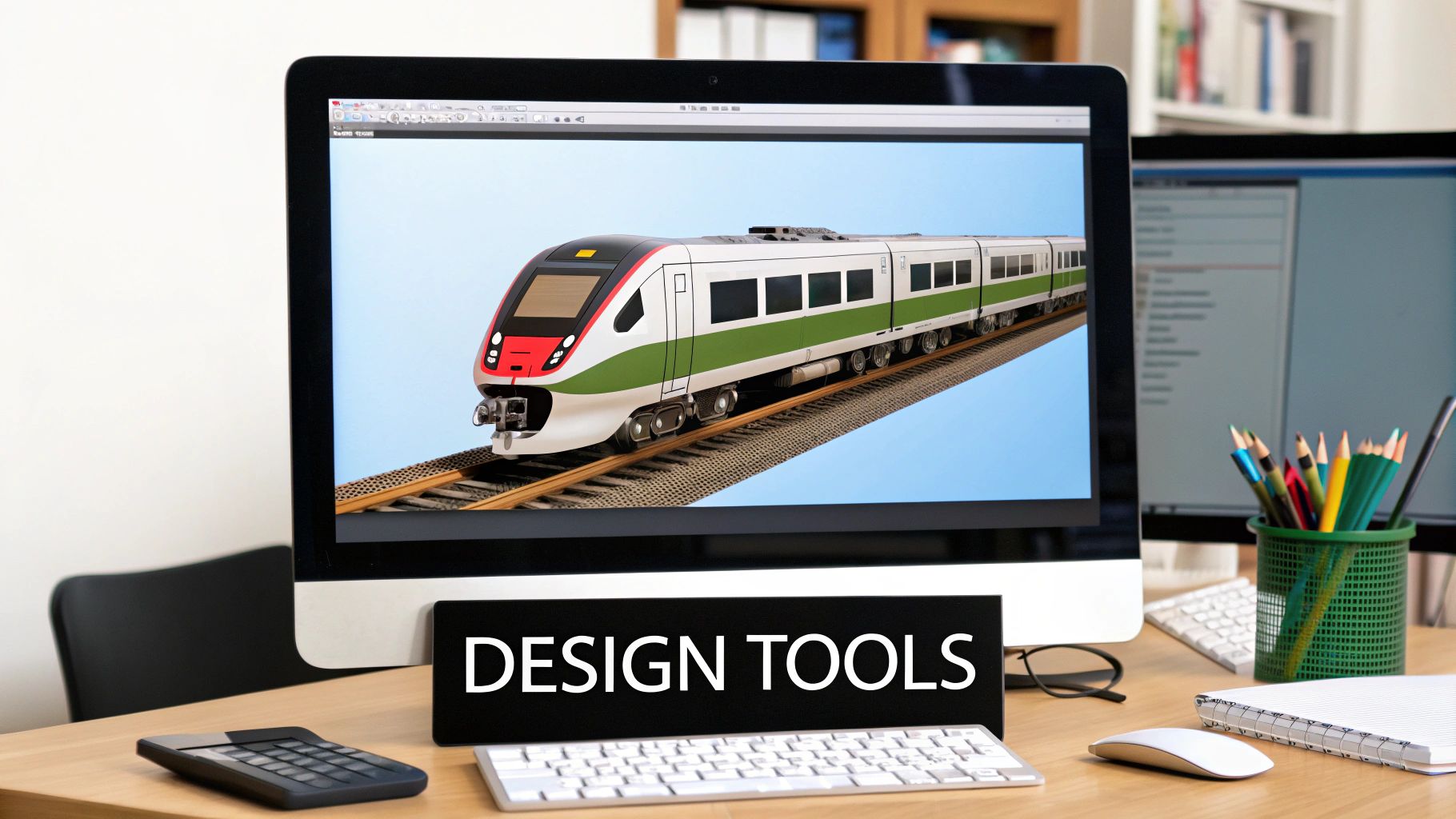
Fine-Tuning Textures for Greater Realism
With a clean mesh, you can focus on texturing—the element that tells your train's story. Was it a hardworking freight engine covered in grime, or a pristine passenger locomotive gleaming under station lights?
Virtuall’s built-in tools allow you to fine-tune every surface. Imagine adding subtle weathering to a steam engine with light rust streaks and soot stains to simulate years of service. Alternatively, you could apply a slick, glossy finish with sharp decals for a factory-fresh look on a modern bullet train.
This stage benefits from a keen artistic eye. To excel here, it helps to understand the principles of effective texturing. We delve into these techniques in our post on AI texture generation.
The goal is to move beyond a generic, AI-generated appearance. You are infusing the model with a unique identity, using the AI's output as a canvas to add nuance and character that automated processes cannot replicate on their own.
Modifying Specific Components
Truly professional 3d train models are defined by their details. That is why Virtuall enables you to isolate and adjust individual components, ensuring every part of your creation is just right. This reinforces our core principle: the user is always in control, with AI serving as a powerful assistant, not a replacement.
This level of granular editing is essential for meeting specific project requirements or achieving historical accuracy.
- Wheels and Bogies: You can adjust the wheel arrangement to match a specific locomotive class or refine textures to show brake dust and grime.
- Couplers and Connectors: If a specific type of coupler is needed for a historical model, you can swap out the default component to ensure mechanical accuracy.
- Cabin Interiors: Even if the interior is not a focal point, adding basic details like seats and controls adds a layer of realism when viewed through cabin windows.
By focusing on these artisanal details, you create more than just a competent AI generation. You are crafting a high-quality digital asset, ready for any professional pipeline, from visual effects to real-time simulations.
Preparing Your Model for Any Application
You’ve refined the details, and your model looks excellent. The final step is to prepare your digital creation for its final destination—whether that's a physical 3D print, a game engine, or an animated scene. This involves ensuring your 3D train models are technically sound and ready for real-world application.
Getting the Scale Spot-On
First, let's address scale. In the world of model railroading, precision is essential. While there are several major scales like N, O, and G, HO scale is globally popular for its balance of detail and manageable size.
An HO scale train uses a 1:87 ratio to the real-world object. You must apply this exact ratio to your digital model before exporting. An incorrect scale can result in a model that is too large for the tracks or too small to print with adequate detail. For more on this topic, you can learn about global model train market trends.
Choosing the Right Export Format
Equally important as scale is the file format. The format you choose determines how other software will interpret your model’s geometry, textures, and other data. Selecting the wrong one can lead to significant compatibility issues.
As this breakdown shows, a large portion of time can be dedicated to the physical printing process.
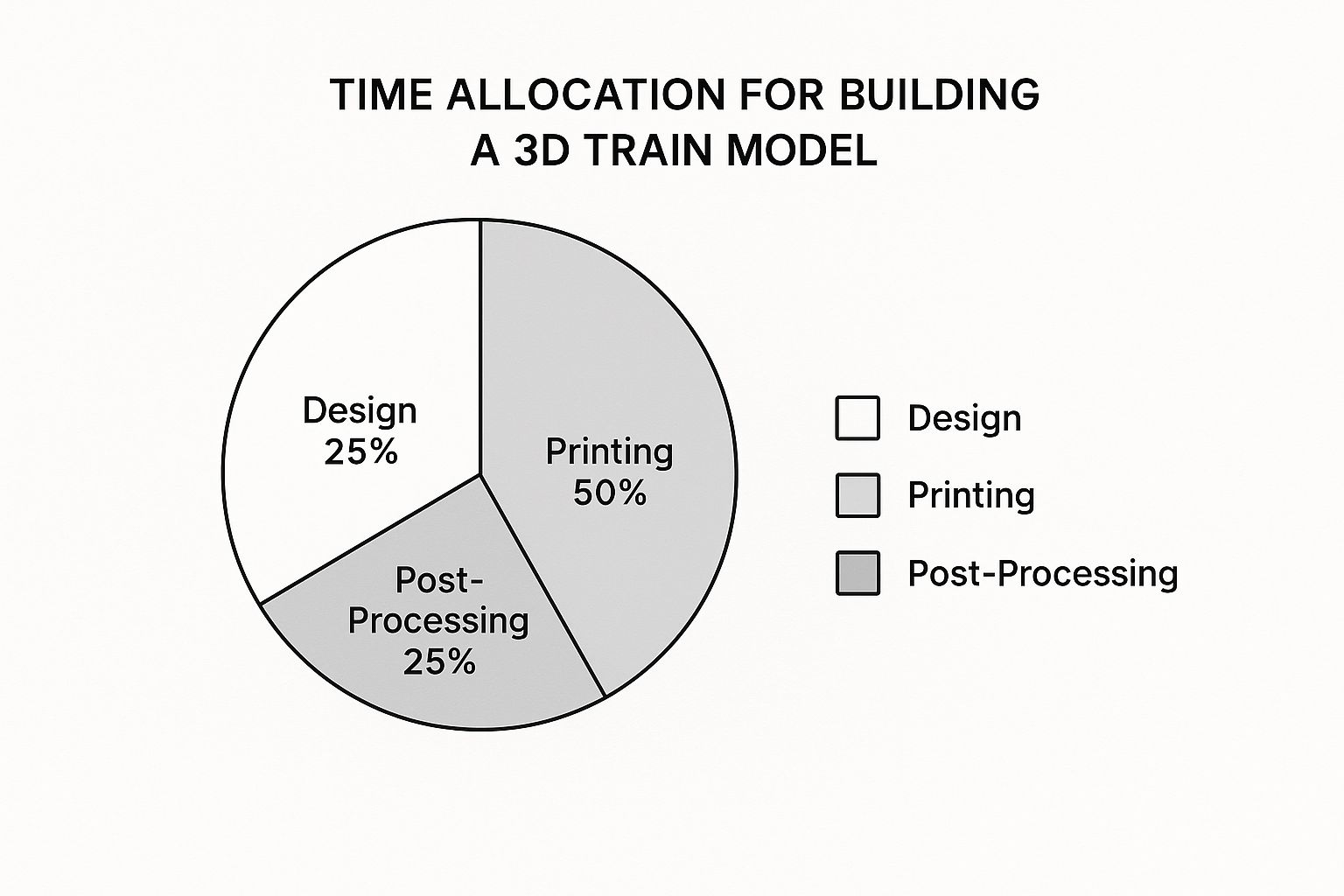
With 50% of project time potentially allocated to printing, configuring export settings correctly from the start is crucial. This helps avoid wasting hours and materials on a failed print due to a simple format error.
A perfectly detailed locomotive is of little use if it cannot be imported correctly into Unreal Engine or sliced properly by your 3D printer's software. Always export with the final destination in mind.
So, how do you choose the right format? It depends entirely on the model's intended use.
To simplify this decision, here is a quick comparison of the most common formats you'll encounter.
3D Model Export Format Comparison
Each format has a specific purpose. If your train is destined for a game in Unity or Unreal Engine, .FBX is your best choice. For a high-quality physical model from a 3D printer, .OBJ is a solid option. And for display on a website or in an AR application, .GLTF is the clear winner.
By establishing the correct scale and choosing the right export format, you ensure your meticulously crafted 3D train models integrate seamlessly into any professional pipeline, performing exactly as intended.
Common Questions About AI 3D Train Modeling
Even with the best tools, adopting a new creative workflow can bring up questions. When it comes to AI generation for a specialized subject like 3D train models, understanding the process is key to achieving great results.
Let's address some of the most common inquiries.
How Detailed Can the AI Actually Get?
This is a frequent first question. The short answer is: surprisingly detailed. AI can generate everything from the main chassis and boiler of a locomotive down to smaller features like rivets, logos, and panel lines.
However, the final level of detail is a direct reflection of the input you provide. Think of it as a collaboration. High-resolution reference photos and highly specific text prompts are essential for guiding the AI toward a high-fidelity result.
A proven workflow is to use the AI for the initial complex shaping, then use built-in editing tools to add the final, precise micro-details. This approach delivers an enterprise-ready model while streamlining the manual effort.
Can I Make Historically Accurate Models?
This is another important question, especially for enthusiasts and production studios. The answer is yes. Success depends on providing the AI with high-quality, specific reference material from the exact era you are targeting.
For example, instead of a generic request like a "1940s steam train," upload historical photos or blueprints and use a prompt such as, “1940s Pennsylvania Railroad T1 class locomotive with a weathered boiler and duplex drive.”
After the AI generates the initial model, you can use the platform’s refinement tools to review every component. This allows you to check and adjust details to meet your historical requirements, combining the speed of AI with the need for precision.
Think of the AI as an incredibly fast and talented assistant, not an autonomous creator. It generates the initial asset based on your precise direction, but you always have the final say and the tools to enforce your vision.
Am I Still in Control of the Final Look?
This leads to the most critical question: creative control. With a professional-grade platform, you always retain complete creative control over the final model.
Platforms like Virtuall are not just about generation; they include robust editing suites for mesh cleanup, texture painting, and modifying individual components. The objective is to ensure the end result is not merely the AI's interpretation but a polished, professional asset that perfectly matches your vision.
The AI can get you 90% of the way there in a fraction of the time. This frees you to focus on that final 10% of artisanal polish that makes the model truly yours.
Ready to accelerate your creative process without compromising control? With Virtuall, you can generate high-quality 3D train models in seconds and refine them to perfection. Start creating with Virtuall today.



